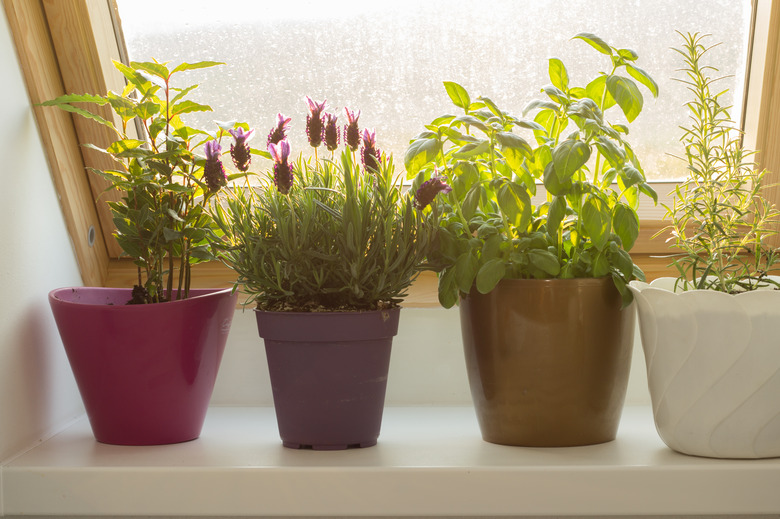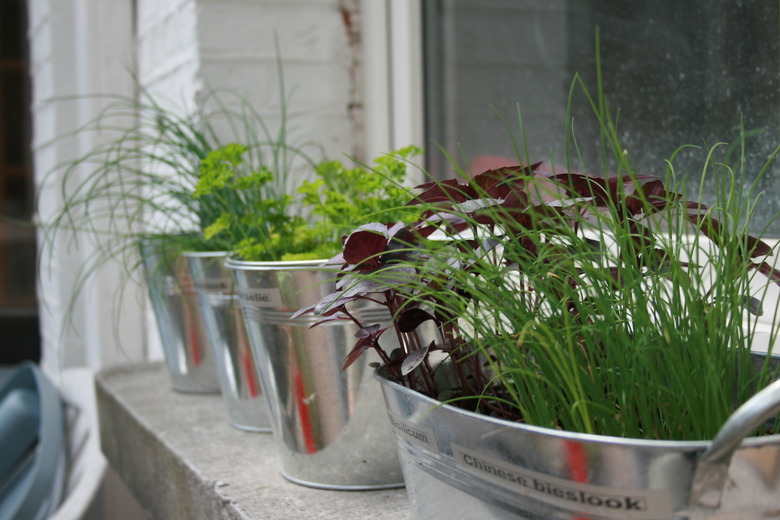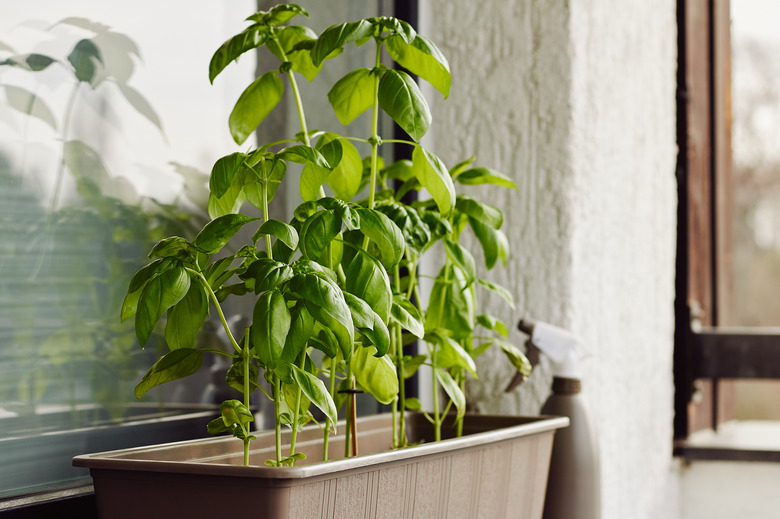Grow Herbs Indoors: A Beginner's Guide
We may receive a commission on purchases made from links.
Why grow herbs indoors? There are so many advantages to an indoor herb garden that it's hard to know where to begin. Growing fresh herbs on your windowsill provides your palate with extravagantly fresh flavors all year long. If you've never tried herb gardening on a sunny windowsill, it's fun and easy as long as you get a basic understanding of how to grow herbs as houseplants.
Starting an Indoor Herb Garden
Starting an Indoor Herb Garden
Many backyards contain outdoor herb gardens with favorites like parsley, mint or basil, but as summer turns into fall, annual herbs die back, and tender perennials wither. Though most of us wouldn't want to wade through mud or snow to clip a little cilantro for our tacos anyway, dried herbs from the grocery store are not a happy alternative.
Enter the indoor herb garden. When you grow herbs indoors, you can have your favorite herbs in your kitchen all year long. Snip fresh basil into pasta, cut mint leaves for tea or chop oregano for a salad. If you are wondering how to grow herbs inside, it doesn't take much. The magic ingredients are enough light, proper drainage, adequate air circulation and sufficient irrigation.
Creating a List
Creating a List
Which herbs should you try to grow? Make the selection the same way you would put together a guest list for a small party — you'd only invite people you like who would get along with each other. Just so, pick herbs you are going to use; otherwise, your indoor herbs are no more than houseplants. Pick your favorite herbs and then cull the list to those that have more or less the same cultural requirements.
What exactly does that mean? Different herbs have different needs, like sun, water and warmth. When you are just starting indoor herb gardening, it's easiest if you pick a handful that share the same growth requirements. That doesn't limit it too much since many herbs need direct sun daily, well-draining soil and regular water. Some popular choices that grow well together include mint (Mentha spp.), lemongrass (Cymbopogon citratus, zones 8-11), and chervil (Anthriscus cerefolium, zones 7-9).
Setting Up an Indoor Site
Setting Up an Indoor Site
When it comes to picking a site for indoor herb gardening, getting the plants enough light is the top priority. Generally, indoor herbs require at least six hours of sun or bright light a day. If your kitchen has a large, south-facing window, you're good to go. If not, see what kind of exposure other windows receive. A kitchen windowsill herb garden is nice, but herbs can also grow happily in sunny windows in the home office, living room or even bedroom, and east- and west-facing exposures can work too.
Even if your house doesn't get much direct sun at all, you can still have an indoor herb garden. These days, it's not difficult to find grow lights that would do the trick. Be sure that the bulbs and fixtures you select offer bright light to keep your herb pots happy. You'll need to situate the plants within a foot of full-spectrum bulbs and then leave the light on for up to 16 hours a day. Installing timers makes the process easier, and you'll be sure your herbs have enough sun. Signs of inadequate sun are plants that are leggy and pale or faded leaves.
While herbs are just fine in a space with typical indoor temperatures (around 65 to 70 degrees Fahrenheit), they may suffer from cold winter nights if you place them too close to the window glass. Keep them away from any drafty windows as well as vents for cooling or heating.
Preparing Herb Containers
Preparing Herb Containers
Herbs can grow happily in clay pots, glazed pots or plastic containers. Since clay pots absorb water, some experts suggest that you don't use these for indoor growing in winter, when heaters reduce moisture anyway. It is critical to pick pots with ample drainage holes, and you'll want a saucer beneath each one to keep draining water off your windowsill. Don't go for tiny pots or huge ones since both extremes create problems. Generally, containers between 4 inches and 6 inches in diameter work well.
When it comes to soil, drainage remains an important factor. Don't just use garden soil since this compacts all too easily. Instead, go for a top-quality potting mix that is rich in organic material. If you leave your herbs in water-saturated soil, the roots will very likely rot, killing the plants.
Setting Up Hydroponics
Setting Up Hydroponics
How about hydroponics? Hydroponics is the practice of growing plants in water. In this type of system, the herb roots either sit directly in water or in a soilless growing medium and get the moisture and nutrients directly. Fans of hydroponics claim that the herbs grow faster, smell better and have more flavor than soil-grown plants.
Not every herb grows well in water. If it's your first time trying hydroponics and/or your first indoor herb garden, you'll do best to try one of these eight hydroponic-friendly plants:
- Dill (Anethum graveolens)
- Anise (Pimpinella anisum)
- Basil (Ocimum spp.)
- Chamomile (Chamaemelum nobile, zones 4-9)
- Greek Oregano (Origanum vulgare subsp. hirtum, zones 4-8)
- Cilantro (Coriandrum sativum)
- Rosemary (Salvia rosmarinus, zones 7-11)
- Catnip (Nepeta cataria, zones 3-9)
You can easily find a hydroponics kit online to get started, but you might also opt for DIY hydroponics. In either case, remember that the herb plants still need daily sunlight to thrive and an occasional dose of fertilizer. Normal indoor temperatures work just fine for this type of growing.
Acquiring the Herbs
Acquiring the Herbs
When it comes to the herb plants, there are several ways a beginning indoor herb gardener can get into the game. If you have had an outdoor herb garden, it's entirely possible to divide outdoor perennial herbs — think oregano, thyme (Thymus spp.) or sage (Salvia spp.)— and transplant small divisions into pots. Take them from the outside of a clump and have a container ready before digging them up.
If you don't grow herbs outside or you hope to grow different fresh herbs in your indoor garden, you can buy starts at the garden center, sow herb seeds or find a neighbor with extras. Seeds take longer to produce mature plants but can be cheaper than buying starts.
How about rooting cuttings? That works well for some herbs but less well for others. It's fairly easy to root soft-stemmed herbs, like basil, mint, oregano and lemon balm (Melissa offinalis, zones 3-7) by cutting a mature stem and putting it in water. Don't try this with annual herbs, like parsley or cilantro. With woody herbs, like rosemary and thyme, only take cuttings from new green growth.
Watering Indoor Herbs
Watering Indoor Herbs
Any potted plant requires more irrigation than plants in the garden bed. That's because the "stomping grounds" for a container plant does not extend beyond the contours of the container.
Take mint for an example. Mint is a notoriously invasive herb, spreading so fast and so far that many gardeners recommend confining your outdoor mint herbs to pots. That also means that you don't really have to worry about mint growing in your outdoor garden. It can send its roots down or horizontally in any direction for moisture. Indoors, the mint roots are stuck with the soil in the pot, and if it dries out, the plant can die.
Indoor herbs need regular water so that they don't ever dry out but not so much that the soil is wet. The exact amount a container herb will need depends to some extent on the size of the pot and the amount of direct sun the plant gets. The easiest formula is the "touch the top of the soil" test. When the top of the soil starts to feel dry, give the herb enough water so that water runs out of its drain holes. Wait 10 minutes and then empty the saucer. Remember that too much water reduces the flavor of the herbs.
Caring for Indoor Herbs
Caring for Indoor Herbs
Light, water and drainage may be the most important requirements when you grow herbs indoors, but they aren't the only ones. Indoor herbs also need humidity to be happy since the indoor air is likely much drier than outdoor air.
You can give them the humidity they need by positioning the pots on top of saucers filled with pebbles and a little water. As the water evaporates, it creates humidity for the plants. Be sure to keep the bottom of the pots out of the water. Spraying them twice a week with water can also help. Sometimes, a small humidifier is the perfect solution.
What about fertilizer? Herbs don't usually need many nutrients, so don't rush gung-ho into the fertilizing habit. If you are convinced that your plants need some nurturing, it won't hurt to add a small amount of water-soluble fertilizer to their water once a month.
Protecting Indoor Herbs From Pests
Protecting Indoor Herbs From Pests
Herbs grown outdoors in the garden don't require much pest protection. Their vitality and strong flavor often keeps chewing insects at bay. Indoors, pests have less choices, and some, including aphids, whiteflies and spider mites, will take whatever green leaf they can find.
Given the culinary purpose of an indoor herb garden, toxins are out of the question. What can you do to keep these bugs away? Your first and best defense is a spray of water. Spray the foliage with a strong stream of water several times to get rid of most of these pests.
If you want to get fancier, use garlic spray made of pureed cloves and water instead. Strain the mixture and then spray it on your plants. You can also buy a mild insecticidal soap, first consulting the label to make sure it's safe for your target plant (some plants are damaged by insecticidal soap). Spray the plant and rinse dead bugs and soap off the leaves thoroughly.
Harvesting Fresh Herbs
Harvesting Fresh Herbs
Don't hesitate to start harvesting your herbs once they grow to about 4 to 6 inches tall. Many herb plants become more vigorous when you snip off growing tips regularly. In fact, some herbs, like basil, stop producing leaves altogether if you allow their flowers to develop.
Use clean kitchen or garden scissors to harvest. Garden pruners work too as long as they are sharp. Generally, you'll just snip off whatever amount you need for your cooking. If you are thinking of taking more, remember never to harvest more than a third of any plant at any one time. Taking too much weakens the little herb plant, and it may take a long time to recover.
References
- Home Depot: How to Grow Herbs Indoors
- Bonnie Plants: How to Grow Herbs Indoors
- The Old Farmer's Almanac: Growing Herbs Indoors
- Learning Herbs: Grow an Endless Supply of Herbs from Cuttings
- Bloomscape: How to Remove Pests From Your Indoor Herb Garden
- The Hydroponics Planet: 8 Easy Herbs to Grow in Hydroponics (With Pictures)


